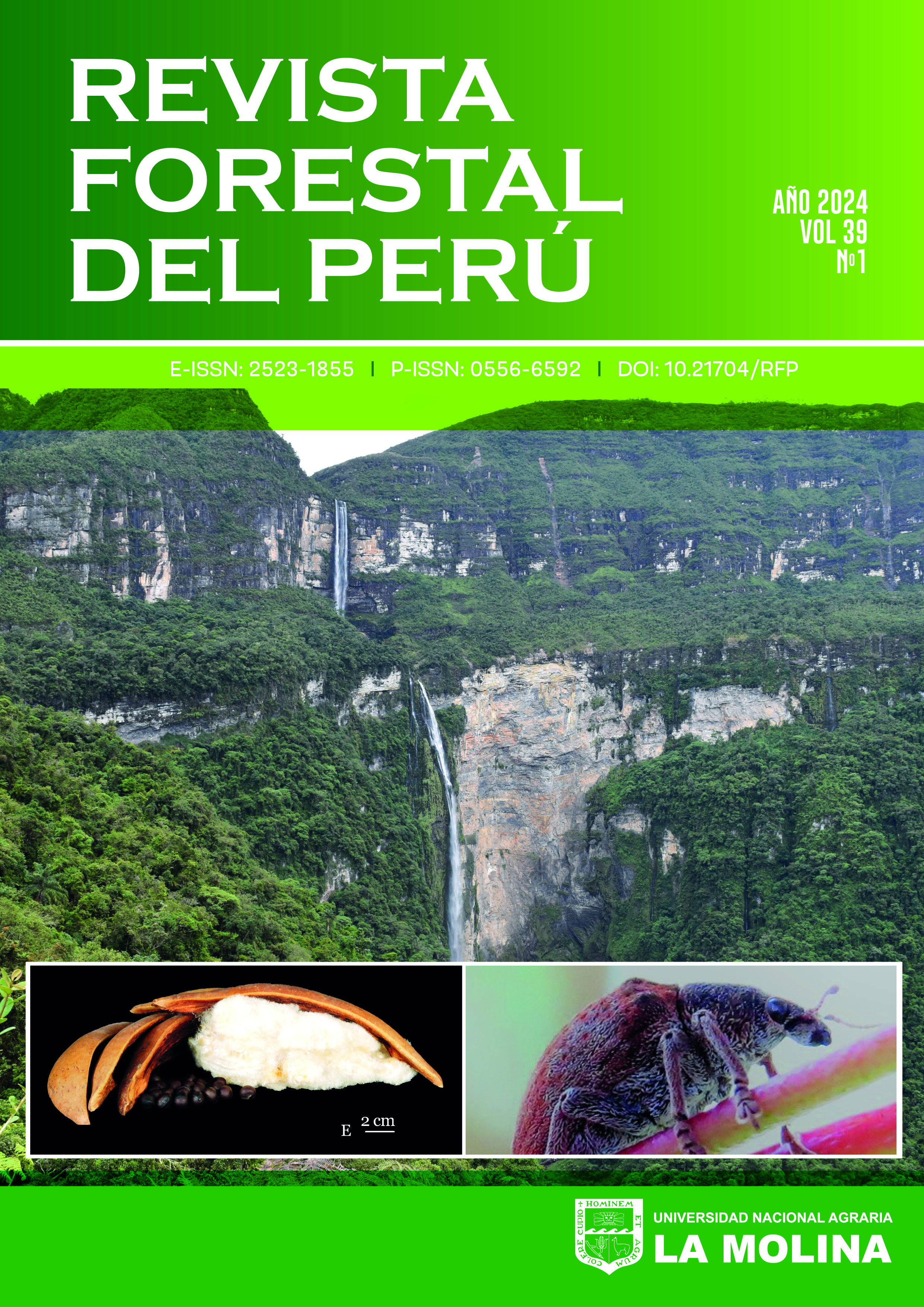Analysis of spatial distribution patterns of individuals of Inga thibaudiana andCedrelinga cateniformis in the Amazon region - Peru
DOI:
https://doi.org/10.21704/rfp.v39i1.2175Keywords:
intensity, nurse tree, management plans, Poisson distribution, pattern addedAbstract
Various authors show that, to carry out adequate sustainable management of forest ecosystems, it is vitally important to have the ability to know the spatial structure of forests with precision and the modifications that forest exploitation can cause to said structure. Thus, the objectives of this study were: to examine and characterize the spatial pattern of the tornillo (Cedrelinga cateniformis (Ducke) Ducke) and guabilla (Inga thibaudiana DC.) and analyze its relationship with the altitude
(m) above sea level, distance (m) from the usable trees to a river and the distance (m) of the usable trees to a seed tree. The statistical analysis was carried out through the tools of analysis of spatial point patterns, which provide a set of methods, which based on the georeferenced location of the species allowed estimating: the intensity of points, the function K(r) and L(r) and perform hypothesis tests of the underlying specific process in the study area. Likewise, based on the formulation of models, the relationships with a set of spatial covariates were evaluated. The methods used show a non-homogeneous spatial pattern of all the tornillo and guabilla trees present in the study areas, clearly perceiving the aggregation of points at short distances (approximately 15 meters) and significant throughout the range studied. Also, it was determined that the intensity of guabilla is related to the distance to the seedbed, while the tornillo is also related to the altitude above sea level and the distance to the rivers, which could be seen in at least one of the four study areas.
Downloads
References
Babweteera, F; Brown, N. 2010. Spatial Patterns of Tree Recruitment in East African Tropical Forests That Have Lost Their Vertebrate Seed Dispersers. Journal of Tropical Ecology 26(2):193-203.
Baddeley, A; Rubak, E; Turner, R. 2016. Spatial point patterns: methodology and applications with R. Chapman and Hall/CRC. 828 p. DOI: https://doi.org/10.1201/b19708.
Bleher, B; Oberrath, R; Böhning-Gaese, K. 2002. Seed dispersal, braeding system, tree density and the spatial pattern of trees–a simulation approach. Basic and Applied Ecology 3(2):115-123.
Camarero, J; Gutiérrez, E; Fortin, MJ; Ribbens, E. 2005. Spatial patterns of tree recruitment in a relict population of Pinus uncinata: forest expansion through stratified diffusion. Journal of Biogeography 32(11): 1979-1992.
Capretz, RL; Batista, JLF; Sotomayor, JFM; da Cunha, CR; Nicoletti, MF; Rodrigues, RR. 2012. Spatial pattern of four forest communities by Ripley’s K function in São Paulo state. Ciência Florestal 22(3):551-565.
Condés, S; Martínez-Millán, J. 1998. Comparación entre los índices de distribución espacial de árboles más usados en el ámbito forestal. Investigación Agraria-Sistemas y Recursos Forestales 7(1/2):173-187.
Corral-Rivas, J; Wehenkel, C; Castellanos-Bocaz, H; Vargas-Larreta, B; Diéguez-Aranda, U. 2010. A permutation test of spatial randomness: Application to nearest neighbour indices in forest stands. Journal of Forest Research 15(4):218-225. DOI: http://dx.doi.org/10.1007/s10310-010-0181-1.
Gray, L; He, F. 2009. Spatial point-pattern analysis for detecting density-dependent competition in a boreal chronosequence of Alberta. Forest Ecology and Management 259(1):98-106.
Malleux, J. 1974. Analisis de dispersion de 10 especies forestales de un bosque húmedo tropical. Revista forestal del Perú 5(1-2):55-66.
Miranda, A; Hernández, HJ; Bustamante, R; Díaz, EM; González, LA; Altamirano, A. 2016. Regeneración natural y patrones de distribución espacial de la palma chilena Jubaea chilensis (Molina) Baillon en los bosques mediterráneos de Chile central. Gayana Botánica 73(1):54-63.
Maltez-Mouro, S; García, L; Marañón, T; Freitas, H. 2007. Recruitment patterns in a medi- terranean oak forest: A case study showing the importance of the spatial component. Forest Science 53(6):645-652.
Palomino, J; Barra, M. 2003. Especies forestales nativas con potencial para reforestación en la provincia de Oxapampa y fichas técnicas de las especies de mayor prioridad. Programa Selva Central Oxapampa, ProNaturaleza. Oxapam- pa, Perú. 109 p.
Pillay, T; Ward, D. 2012. Spatial pattern analysis and competition between acacia karroo trees in humid savannas. Plant Ecology 213(10):1609-1619. DOI: http://dx.doi.org/10.1007/s11258-012-0115-4.
Penttinen, A; Stoyan, D. 2000. Recent applications of point process methods in forestry statistics. Statistical science 15(1):61-78. DOI: https://doi.org/10.1214/ss/1009212674.
Pommerening, A; Stoyan, D. 2008. Reconstructing spatial tree point patterns from nearest neighbour summary statistics measured in small subwindows. Canadian Journal of Forest Research 38(5):1110-1122. DOI: https://cdnsciencepub.com/doi/abs/10.1139/X07-222.
Quispe, B. 2016. Modelos estadísticos en pro- cesos puntuales espaciales Poisson para evaluar la distribución espacial de los hechos delictivos en Lima, Perú. 99 p.
Richards, PW. 1996. The tropical rain forest. Second edition. Cambridge University. United Kingdom. Great Britain. 575 p.
Salinas-Melgoza, MA. 2016. Aspectos ecológi- cos de patrones espaciales de árboles tropicales, caracteres de historia natural y tipo de hábitat en una selva húmeda neotropical. Tesis de doctorado. Chajul Chiapas, México. 94 p.
Saboya, N. 2013. Distribución espacial de las especies arbóreas aprovechables, de la parcela de corta anual 2 bloque II de la comunidad nativa Santa Mercedes, rio Putumayo, Perú. Tesis de doctorado. Universidad Nacional de la Amazonia Peruana. 81 p.
Torres, MT. 2013. Análisis de los patrones de distribución espacial de las poblaciones de agaves invasoras en la llanura costera eólica del parque natural de Cabo de Gata-Níjar. Trabajo Fin de Grado de la Universidad de Almería. 52 p.
Traissac, S; Pascal, JP. 2014. Birth and life of tree aggregates in tropical forest: hypotheses on population dynamics of an aggregated shade-tolerant species. Journal Of Vegetation Science 25(2):491-502. DOI: https://doi.org/10.1111/jvs.12080.
Webber, BL; Norton, BA; Woodrow, IE. 2010. Disturbance affects spatial patterning and stand structure of a tropical rainforest tree. Austral Ecology 35(4):423-434.
Wiegand, T; Martínez, I; Huth, A; Associate Editor: Peter D. Taylor, & Editor: Donald L. DeAngelis. 2009. Recruitment in Tropical Tree Species: Revealing Complex Spatial Patterns. The American Naturalist 174(4):E106-E140. Disponible en http://www.jstor.org/stable/10.1086/605368.
Downloads
Published
Issue
Section
License
Copyright (c) 2024 Juan E. Izquierdo

This work is licensed under a Creative Commons Attribution 4.0 International License.





